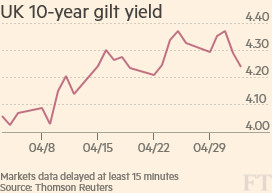EU referendum markets watch: 1 day to go
Simply sign up to the Currencies myFT Digest -- delivered directly to your inbox.
One day remains until UK voters decide whether to stay in the EU. Here are the latest readings on markets and investor reaction in the countdown to the June 23 EU referendum
Currencies

The pound rallied earlier this week as the Remain camp erased most of the Leave camp’s opinion poll lead. Leave regained a 1 per cent lead on Tuesday and the pound fell, a currency move that was partially reversed on Wednesday as polls moved back at 44 per cent each.
Sterling rose 0.2 per cent to $1.4668, after touching a high of $1.4773, near this year’s peak of $1.4813. Against the euro, the pound fell slightly to 76.85p, ending its five-day rally.
“Polls . . . have the potential to move market expectations either way, but the reluctance of investors to move unambiguously in one direction is a reflection of how tight polling has been,” said Dean Turner, Economist at UBS Wealth Management. “Once the result starts to become clear on Friday, we expect that markets will move quickly.”

The pound has been volatile since David Cameron announced the date for the referendum in late February. The currency is still comfortably above its $1.3836 low for the year, and over the $1.40 level for the pound has been the floor for the currency since the mid-1980s.
The currency is expected to remain volatile. The cost of hedging against big moves in the pound — as measured by the one-week sterling volatility — rose to 43.86 on Wednesday afternoon London time. The rise marks a reversal of the easing trend of the previous two days. Last week, it nearly touched 50, more than the level reached in the run-up to the Scottish independence referendum and the 2008 financial crisis.
Government bonds

Investors worried about both Brexit and global growth have been seeking haven assets, increasing demand for UK government bonds
A resurgence of Remain in the polls sharply reversed demand. The 10-year gilt yield, which moves in the opposite direction to a bond’s price, ended the London trading day at 1.313 per cent on Wednesday. The benchmark set a record low of 1.07 per cent less than a week ago. Demand for the two-year gilt increased on Wednesday, reversing a recent trend, ending the day down one basis point at a yield of 0.488 per cent.
Plenty of fixed-income strategists believe it could shoot through 1 per cent if the UK votes to leave.
Strong demand for UK government bonds has undermined UK Treasury warnings that a decision to leave the EU would trigger a sharp rise in borrowing costs for the government and companies.
Bookmaker odds

Betting markets swung strongly back in favour of Britain voting to stay in the EU this week.
The implied probability of a Remain vote continued to hover 75 per cent, up 17 per cent from a low of just under 58 per cent at midday on Thursday 16 June, according to odds compiled by Betfair.
Late on Wednesday afternoon, the FT poll of polls showed the two camps were even at 44 per cent, as Leave lost the 1 per cent lead it gained late on Tuesday.
Equities

UK stock markets sustained their recent upward momentum on Wednesday with the FTSE 100 closing up 0.6 per cent to close over 6,200. Banks, insurance, metals, mining and pharmaceuticals led the gains.
The blue-chip index has not been the focus of investors’ Brexit fears as the majority of its revenues are international and might benefit from a weaker pound should the referendum deliver a leave result.

In contrast, FTSE 250 companies earn about 70 per cent of their revenues domestically and have been more sensitive to Brexit fears. The mid-cap index has lagged behind the FTSE 100 this year.
Even this index, though, climbed on Wednesday to close up 0.4 per cent, with asset managers and custody banks leading the gains.
Reporting by Richard Blackden, Rochelle Toplensky and Roger Blitz
————————-
UK’s EU referendum: full coverage and analysis

View the FT’s comprehensive guide to the vote on whether Britain should stay in Europe, with all the latest news, analysis and commentary from both sides of the debate. See more
————————-
Comments